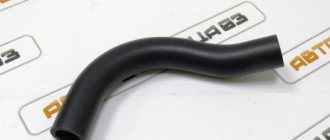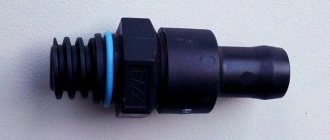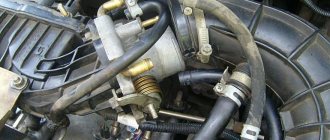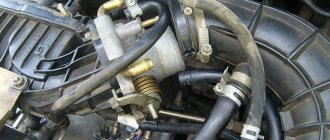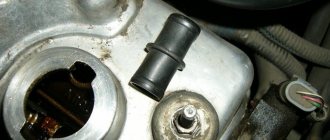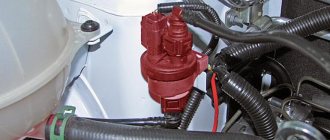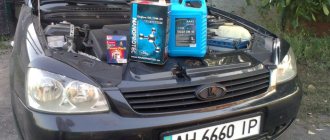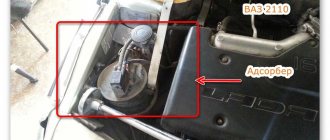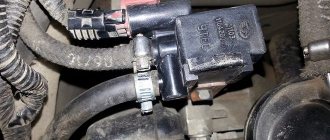The crankcase gas cleaning system is the simplest and lightest thing in the engine. And, meanwhile, it needs increased attention from the driver. We are talking about constant care: inspection, cleaning and testing of the system; you also need to pay special attention to the crankcase ventilation valve (CVG).
Preventing the release of gases containing the entire periodic table is the main task of this system. Its device is designed not only to keep the surrounding area clean, but also to reduce the result of gas pressure on internal combustion engine parts to a minimum value.
Why do you need a crankcase ventilation system?
The fact is that when an internal combustion engine operates, the penetration of a certain amount of gases from the combustion chamber into the engine crankcase is inevitable.
These gases leak through leaks between the piston and the cylinder walls. Plus, the pressure in the crankcase constantly changes due to temperature changes. Erupted gases have a detrimental effect on the properties of the oil and the environment, and also increase the pressure in the crankcase, which will inevitably lead to leaks at the engine seals and excessive oil consumption.
This system is needed to remove these gases and reduce pressure in the engine crankcase.
What does it consist of?
- Pipes, hoses;
- Oil separator;
- Control valve.
In classic VAZ models, crankcase ventilation is simplified; there is no valve.
Scheme of work
- Gases enter the oil separator through hoses, where oil vapors are separated from gases;
- Next they enter the ventilation valve. It is connected to the intake manifold. The vacuum in it “sucks” them back into the intake.
Thus, we get rid of excess pressure.
In domestic cars, the breather plays the role of an oil separator. It is directly connected to the power unit. Oil passing through it settles on its walls. It is directly connected to the intake. One hose is connected to the air filter housing; pumping occurs during engine load. The second hose is connected to the carburetor, below the throttle. It is needed for crankcase ventilation at idle speed of the internal combustion engine.
Video: Crankcase ventilation system
Oil separator
It happens:
- Tangential;
- Labyrinthine.
In the first case, crankcase gases enter the oil separator housing at an angle. They twist and receive tangential acceleration. Due to centrifugal force, the oil emulsion and vapors remain on the walls of the separator and flow back into the engine sump. The gas flow continues into the valve.
Advertising:
The second type has a labyrinth in its design (it is logical to assume from the name). Crankcase gases passing through it, hitting its walls, flow into the sump.
Crankcase ventilation valve
Necessary for adjusting the intensity of the “suction”. A large vacuum can form in the engine intake manifold at different operating modes. A large vacuum can be created in the crankcase through the ventilation system. The higher it is, the more combustion products of the air-fuel mixture will “break through” the compression rings into the engine volume.
When excess pressure is created, the valve opens, gases are “sucked” into the inlet, and the pressure decreases. When a vacuum is formed, it closes, preventing the creation of a large vacuum. Thus, the extraction of fuel combustion residues, gasoline vapors, etc. is adjusted. from internal combustion engine.
Diagnostic methods
The easiest way to check the PCV valve is by yourself. To do this, just blow into the valve from the side of the valve cover. If the air pressure from the reverse side is weak or does not come out at all, the valve is not working properly. Cleaning the crankcase ventilation system with carburetor cleaner should correct the situation. If the valve is blown in both directions, most likely it is stuck in a half-open state, or the rubber membrane is torn.
The degree of contamination and the overall efficiency of the crankcase ventilation is measured in two main ways:
- The crankcase gas pressure is measured at different engine operating modes.
- The volume of gases that the system can pass through itself is measured.
In order not to encounter the consequences of malfunctions of the VKG system, it is worth periodically changing the PCV valve, filter element, and cleaning the centrifugal/labyrinth oil trap.
What is the purpose of and where is the crankcase ventilation valve (CVVV) located?
The crankcase ventilation valve is needed to pass exhaust gases that accumulate in the engine crankcase back into the combustion chambers of the cylinders through the intake manifold. The KVKG is usually located in the intake manifold. There are two types of crankcase ventilation: forced and non-forced.
Diagram of the crankcase ventilation system
Typical faults
All problems that may arise with this device can be divided into two types - various valve failures and clogging. We will talk about them below. Very often, among the reasons why the crankcase gas valve fails (Polo 1.4 is no exception), natural wear and tear of components and parts in the cylinder-piston group is identified. If there is weak compression in the combustion chambers and the oil scraper ring on the piston does not retain lubricant, then the gas pressure in the crankcase increases. The ventilation system cannot cope with this phenomenon. Oil, soot and other combustion products literally clog the pipes and hoses, thereby compromising the integrity of the valve membrane.
If the ventilation system pipes become clogged and clogged, gases will try to escape through any possible places and connections. Therefore, the gaskets leak and oil is squeezed out through the seals.
Design and principle of operation of the crankcase ventilation valve
The ventilation valve has such a simple device that even a novice car enthusiast can easily learn how to disassemble and clean it.
Scheme of gas movement through the ventilation valve
It consists of:
- Plastic case.
- Lids.
- Inlet and outlet fittings.
- Two cavities.
- Membranes.
- Springs.
The principle of operation of the valve in modern cars
Video about the operating principle of the crankcase ventilation system and valve.
The ventilation valve opens in medium mode, when optimal pressure is created on the membrane. In this position, the valve overcomes the spring pressure. After passing through the oil separator, the gases are cleared of oil droplets, pass into the open valve and complete the cycle, returning back to the combustion chambers, where their combustion is completed. If we are talking about a non-forced crankcase ventilation system, then the valve almost does not open in idle mode and is closed at high speeds. At high speeds, a lot of gases are released, and hot gases often leak into the intake manifold. In this case, the valve is closed, since there is a risk of ignition of crankcase gases in the crankcase itself.
Operation of the crankcase ventilation valve in different modes
Where do the gases go if the valve is closed?
In any case, crankcase gases must be removed and under no circumstances remain inside the system. There is another iron pipe that leads to another valve. This is the so-called “fungus” or pressure reducing valve. When the main valve is closed (and this happens, let me remind you, at high speeds and at idle), the gases pass through this iron pipe directly into the “fungus”.
It also has two states: closed and open. When it is covered, a small calibrated hole inside it opens slightly, which allows the gas mixture to pass through. In this case, the gases escape through a large hole. That is, a system consisting of two valves ensures uninterrupted and reliable crankcase ventilation.
Operating principle
When a mixture of fuel and air burns in a chamber at very high temperatures, nitrogen is released. Together with oxygen, it can form dangerous substances that have a detrimental effect on the environment. These are nitrogen oxides. Under certain conditions, the combustion temperature in the engine combustion chamber is higher than standard, due to which the volume of nitrogen oxide emissions increases significantly.
Most of it is trying to break into the bottom of the engine block. To prevent the pressure from rising to a critical level, it must be released. Until a recirculation system was introduced on engines, gases, as already noted, were removed through the breather in the engine crankcase. Let's look at how the crankcase valve works. The operating principle is very simple. It is based on the effect of vacuum in the intake manifold. Due to this, through a vacuum converter, the valve shaft moves, thereby opening the device. There are two types of devices used in modern cars. These are mechanical and electronic systems. In turn, electronic ones are divided into two more types - discrete and linear.
There is a vacuum connection in the vacuum diaphragm housing on the cylinder block. It is attached to the carburetor or throttle angle. Depending on the vacuum that occurs in the intake manifold, the diaphragm curtain presses on the continuously variable shift lever during the opening process. As a result, a special signal is generated to open the membrane of the electronic valve. As the signal level increases, the diaphragm begins to move upward, overcoming the force of the spring and moving the plunger. This will create a hole in the valve. Gases may enter the intake manifold. If the engine is idling or when the vacuum level in the manifold is low, the plunger closes. Gases will not enter the collector.
Signs of a bad PCV valve
The aforementioned cloudy or milky film is just one sign of a faulty PCV valve. However, this phenomenon may also indicate other problems. If there is moisture in the system, then replacing only one KPVKG will not solve the problem; you will definitely need to change the oil.
Experts also recommend changing the oil more often for those who travel short distances. Due to frequent stops and short distances, the engine often does not reach operating temperature, as a result of which moisture may accumulate in the system and not be completely removed by the positive crankcase ventilation system.
Dirty oil and increased oil consumption are also signs of a bad PCV valve. A dying valve may make a whistling noise. To understand whether the PCV valve is the source of the noise, just shut off the hose going to the valve and listen to see if the noise has changed.
In some cases, a faulty CPVCG can cause oil to appear on the air filter. If you see a dirty or oily spot near the valve inlet hose, this indicates a problem with the valve. Jamming of this unit can cause errors to appear (codes: P0171 and P0174), as well as the appearance of corresponding indicators on the instrument panel (“CHECK” and oil pressure light). You should also pay attention to errors in the lambda probe and mass air flow sensor, which may be associated with this device.
If the PCV valve fails or has already failed, there will be an increase in internal engine pressure, possibly black smoke, and rough running of the engine.
If the valve is stuck, you will notice other signs. If the hose is jammed open or the hose ruptures, a vacuum leak will occur, this will be accompanied by interruptions in engine operation at idle, the fuel assembly will become “poor,” oil consumption will increase, and oil loss will begin.
A jammed open PCV valve can also cause an error to appear, including the sensors that I mentioned above (lambda and mass air flow sensor). If the diagnosis is incorrect, you can replace completely working sensors, but this will not solve the problem.
About blockages
The Passat B3 crankcase gas valve, like all others of this type, is susceptible to clogging. This may cause the mechanism to jam. The phenomenon will certainly affect the performance of the engine. If the valve is stuck in the open position, the idle speed will increase, and fuel consumption may increase significantly. Engine idling will become unstable.
If the crankcase gas valve (Skoda Octavia often suffers from this) gets stuck in the closed position, then an increase in gas pressure in the crankcase will be observed. Oil leaks are observed from all kinds of oil seals and seals. Often, such malfunctions significantly disrupt the operation of the lubrication system.
Symptoms of a Stuck PCV
- Engine misfires at idle
- Lean air-fuel mixture
- Presence of engine oil in PCV valve or hose
- Increased oil consumption
- Hard engine start
- Rough, unstable engine operation at idle
Additionally, a stuck PCV valve can cause a check engine light due to increased air flow. And the diagnostic computer may mistakenly show this error due to the mass air flow sensor or oxygen sensor, making it difficult for you to identify the real source of the problem.
Serious damage to the engine
Burnt gases have a negative impact on the oil and reduce engine efficiency. In fact, crankcase gases are unburnt fuel residues and contain many harmful impurities that have a detrimental effect on the environment. The presence of water evaporation in gases leads to the formation of an emulsion, due to which foam is observed in the oil. Because of it, the rubbing elements do not receive a sufficient amount of lubrication, due to which they wear out faster and fail. And the vapors themselves that fall on the oil dilute it. Various impurities are formed, which have the most destructive effect, reducing the durability of almost all parts with which the oil comes into contact. As a result, the engine life is reduced several times.
How to check the crankcase ventilation valve
Modern automobile engines use membrane-type CVCV (PCV). The design of such a valve is extremely simple; in the standard version it has:
- a housing on which there are two fittings - for supplying crankcase gases and for removing them;
- cover;
- diaphragm (crankcase ventilation valve membrane);
- return spring.
The operating principle of this mechanism is as follows:
- when the engine is turned off, the valve is closed by a membrane under the force of the spring;
- at idle speed, under the influence of vacuum, the membrane begins to overcome the force of the spring, and part of the CG passes from the internal combustion engine into the intake tract;
- at high speeds, the diaphragm completely clears the channel, and crankcase gases are sucked into the intake manifold in full.
As the valve becomes clogged, it stops working, but before changing the KVKG, you should still check it. A serviceable KVKG removed from the engine should be blown in one direction; in the opposite direction, air passes through it in a small volume.
You can also check the valve with the engine running; to do this, you need to disconnect the hose from the device on the intake side. On a working CVCG there is a vacuum, and if you put your finger on the fitting, you will feel like your finger is being “sucked”. If the device is faulty, no vacuum is created.
Through the engine ventilation system, you can check how well the piston group of the internal combustion engine “feels”. The check is done as follows - a simple transparent fuel filter is installed between the PCV and the intake manifold. If after a short mileage oil and soot appear in the filter, it means that the piston rings are not in order and the engine needs repair.
Video - How it works and how to check the PCV valve
In this video, I showed how to check the valve programmatically and physically, and also showed how a working valve differs from a faulty one. And also original from non-original
How long does a PCV valve last?
It all depends on operating conditions and many factors. With proper maintenance and regular oil changes, the device “lives” for quite a long time. Otherwise, the accumulation of dirt and various inclusions in the engine oil will significantly reduce the service life of the PCV valve, up to its complete failure.
Pros and cons of a closed crankcase ventilation system
Disadvantages of the crankcase ventilation system:
- oiling of the engine intake tract - regular cleaning is required
- if the engine is in poor condition, the volume of crankcase gases is so large that you can forget about the normal operation of the system and the engine - engine repair is required
Advantages of the crankcase ventilation system:
- our air is cleaner, since crankcase gases are much more toxic than exhaust gases
- less chance of seeing leaks through seals and seals
- engine oil life increases
- oxidative processes inside the engine are reduced
- crankcase gases increase knock resistance
- the crankcase does not communicate with the atmosphere, as a result of which dust and moisture are not sucked into it
Replacing KVKG
Replacing a valve is easy on almost any passenger car, but each SVKG engine model has its own design features. Let us consider, as an example, how the KVKG changes on the M54 B22 engine, the make of the car is a BMW fifth series in the back of an E39. The KVKG valve is located under the intake manifold at the front of the internal combustion engine, and to get to it you need to remove:
- electronic throttle;
- idle speed controller.
For convenience, you can remove the intake manifold itself, but then the work turns out to be quite labor-intensive, and you will also have to purchase manifold gaskets. After access to the valve is ensured, disconnect the hoses from the KVKG and dismantle the device itself. We are installing a new mechanism, putting all the parts in their places.
Consequences of faulty crankcase ventilation
Consequences of high pressure in the crankcase:
- Damage to the rubber seals of the crankshaft and camshaft. The engine will lose oil through squeezed out oil seals. If a sharp decrease in level is not noticed in time, oil starvation can lead to wear of the rubbing pairs and rotation of the liners.
- Turbine failure. After lubricating and cooling the turbocharger parts, the oil should drain by gravity into the pan. If there is a backlash of gases in the crankcase space (a kind of plug), the volume of engine oil pumped through the turbine will sharply decrease. Due to deterioration of heat dissipation, the oil will begin to coke inside the channels and on hot rubbing vapors. The consequence is scuffing on the liners and turbine shaft, which is equivalent to a deep restoration or replacement of the cartridge/turbocharger assembly.
- Squeezing out the dipstick and splashing oil into the engine compartment. In some cases, the dipstick flies out with such force that it leaves a noticeable dent in the hood. In this case, you won’t be able to get rid of it just by washing the engine compartment.
Video: Crankcase ventilation system
Advantages and importance of using the device
Using a moisture separator when painting a car with a compressor unit significantly increases the service life of the coating and protects the body from corrosion. The air must be dry - this is achieved through the use of refrigeration equipment, centrifugal force or silica gel. You can assemble a homemade device from an old cylinder, fire extinguisher, oil or water filter.
Some compressor units supply high pressure air and require factory filters and dehumidifiers. Before connecting the dehumidifier, carefully read the manufacturer's instructions and make sure that all requirements for the air mixture will be met.
In order for the compressor unit to apply a layer of paint more efficiently, experts recommend supplying dry air into it. You can remove excess moisture using homemade moisture separators. They will cost less than factory ones and, if manufactured well, will work reliably and efficiently for a long time.
PCV system maintenance
Sometimes, bad valve symptoms are mistakenly reported as coming from a bad sensor. This is why it is important to regularly check the PCV and related components. It takes only a few minutes. If your engine is missing a valve, or you can't get to it without removing one or more components, consult your repair manual for the best way to check your specific system. Also, check your system's maintenance schedule and replace necessary components at regular intervals, even if it appears to be in good condition. Most PCV valves and related components are inexpensive and will save you money on costly repairs if you replace them at the recommended interval.
Features of the crankcase ventilation system on VAG vehicles
Crankcase ventilation on VAG cars has a relatively complex design. The system uses a huge number of plastic parts and rubber pipes. During active use of the car, the hoses become coked. Then you have to clear all the elements. Previously, in this case the problem was solved simply. Bypassing the ventilation system, a pipe or hose was installed on the valve system cover and released gases into the environment. But this method has a lot of disadvantages. Gases seriously pollute the environment; the driver and passengers inside the car also breathe them.
Nobody does this anymore on modern cars, but if the crankcase gas valve on a VW is clogged, then the owner needs to clean the entire system. Crankcase gases on VAG group engines are not discharged from the valve cover, but from the engine block, in the hole of which an oil separator is installed (located on the right side of the block). The device does not allow oil to rise through the pipes in the SVKG. It is the gases that get there and nothing else. A plastic tube is attached to the oil separator, and a tee is installed between the hose and this tube, in which the valve is located. It can operate in three modes. It is closed at idle and high speeds, and opens when the engine runs at medium speeds.
How to remove KVKG on M54 - basic rules
Before removing the KVKG on the M54, many car enthusiasts wonder how advisable it is to do this. It would seem that it was created for a specific purpose and should be useful. Therefore, you must immediately weigh all the pros and cons of such an event.
The advantages of deletion will be the following:
- No oil backflow into the intake manifold.
- The system will not freeze due to extreme cold.
- Clean air will flow to the motor.
- Ensures more stable operation of the motor.
The disadvantages of removing KVKG will be the harm that will be caused to a given vehicle without this system.
Why was this device invented? It allows crankcase gases to return inside the exhaust manifold. Otherwise, they would go outside, polluting the external environment. After all, exhaust gases are dangerous for people. But there are also a lot of problems because of this system. That’s why drivers are thinking about removing the KVKG on the M54.
Cost of the KG ventilation valve
The cost of KVKG can be completely different; the price largely depends on the car model and the engine itself. For example, an original valve for an M54 (BMW) internal combustion engine costs about 2200-2400 rubles; this device is also suitable for M52 series engines and is installed on E39 5-series cars, X3, X5, BMW Compact. For Ford cars (Duratec HE engines), a ventilation valve can be purchased at an average price of 1300-1800 rubles, the cost depends on the seller - custom parts are cheaper if the parts are not needed urgently.
There are original parts that are quite expensive, and besides, they cannot always be found on sale, so it makes sense to buy contract spare parts - they are much cheaper and more accessible. For example, even a contract Mitsubishi KVKG for the 4G94 engine from Vladivostok will cost about 3 thousand rubles; it is difficult to say how much the new mechanism costs. You can also search for more details in car dismantling yards and various advertisements on the Internet.
Sources
- https://MoyLacetti.ru/sistema-ventilyacii-kartera/
- https://akki-carsh.ru/dvigatel/chistka-sistemy-ventilyacii-karternyh-gazov.html
- https://avtomotoprof.ru/obsluzhivanie-i-uhod-za-avtomobilem/ventilyatsiya-kartera-dvigatelya/
- https://VazNeTaz.ru/klapan-ventilyacii-karternyx-gazov
- https://vopros-avto.ru/klapan-pcv-chto-eto-i-dlya-chego-priznaki-neispravnosti-klapana-pcv-i-sposoby-proverki/
- https://santavod.ru/kak-proverit-klapan-ventilyaczii-karternyh-gazov-pcv/
- https://avtobrands.ru/znachenie-sistemy-ventilyatsii-karternyh-gazov-v-dvigatele/
- https://MoyLacetti.ru/klapan-pcv/
- https://avtika.ru/kakuyu-ventilyatsiyu-kartera-imeyut-bolshinstvo-avtomobilnyh-dvigateley/
- https://FB.ru/article/299022/kak-proverit-klapan-karternyih-gazov
Instructions for replacing the valve kvkg n52 valve cover 11127552281 BMW
1. Remove the membrane cover (the process is described in detail in the instructions for replacing the membrane 11127552281 - see below).
2. Remove the old membrane.
3. Clean the valve wall from oil deposits (mechanically).
4. Install the valve spring (the original spring from the old diaphragm).
5. Place the valve in place (the valve fits tightly, so you need to clean the seat well; you can use sealant for additional fixation).
